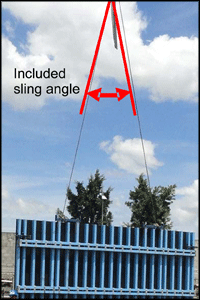Risks associated with lifting formwork
Issued: 19 December 2011
Last Updated: 7 December 2011
Purpose
The purpose of this safety alert is to highlight the risks associated with lifting formwork and the need to make sure the lifting method is safe.
Background
A construction worker died when a wall form dropped while being lifted with a two-legged sling. It would appear that the two vertical timber posts that the lifting lugs were attached to failed.
Contributing factors
The extra side loading caused by the lateral force when the form was lifted was a major contributor to this incident. Side loading is applied to the form and lifting lugs by the lifting hooks on the sling when the form is raised or flipped over. When the included angle of a multi-leg sling is increased, the side loading will increase.
The main hazards involved in lifting formwork include:
- not adhering to engineer specifications for lifting the form
- having an included sling angle greater than specified by the engineer
- lifting lugs that cannot withstand the side load.
Actions required
Ensure the included sling angle is minimised wherever possible - ideally less than 90 degrees. This will help to reduce the load on the chains and side load on the form.

Photograph 1 - Minimise the included sling angle whenever possible.
Dogging practice allows for the use of a range of included sling angles up to 120 degrees.
When designing formwork shutters the maximum sling angle and the lifting points need to be considered in the design.
The lifting parts of the form should be designed to withstand side load caused by the included sling angle. The maximum sling angle or slinging arrangement must be clearly marked on the form.
Always make sure:
- there is an engineer's drawing or certification for lifting the form
- the lifting lug type, location and attachment are the same as specified on the drawing
- the types and spacing of members on the form are the same as those specified on the engineer's drawing
- the numbers, types and spacing of bolts and screws on the form are the same as those specified on the engineer's drawing
- the form is engineer certified for any side loading lifting (i.e. when flipping the form onto or when using multi-legged slings)
- any bracing on the form is the same as that specified on the engineer's drawing
- a competent person from the formwork contractor inspects the form every time it is lifted and verifies it is safe to lift.
- there is a documented maintenance system so the forms are inspected for damage or deterioration and remain safe.
It's important to:
- never lift a wall or column form unless the form complies with the engineer's drawing
- never lift a form that has lifting parts that are damaged or rotten
- never change the lifting points without engineer approval
- never drill extra holes in the lifting parts of the form
- never use bolts, screws or timbers different to those listed on the engineers drawing.